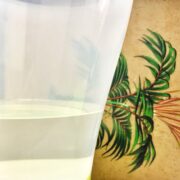Skin problems can cause embarrassment. This can be especially true for skin problems affecting the “nether regions” — areas of the body that so many of us are taught to think of as shameful, not to be spoken of, or at least extremely private. Of course, they aren’t shameful and we should all know more about skin problems that appear on the genitals, or that are related to sex or our undergarments. Furthermore, we shouldn’t be shy about consulting a dermatologist to make sure that we get an accurate diagnosis and address the problem properly.
Darkening and other Skin Problems in the Groin, Stomach, and Bra Areas
Elastics, dyes, chemical processing (bleaching), scratchy fabrics, and preservatives in fabric can cause itching, rashes and, over time, darkening around the groin, scrotum, buttocks, bra area, and stomach. But it’s not just underwear that can cause these problems. Seats and lower back cushions with leather, rubber, vinyl, and other allergens can also be at fault.
While a rash, itching, or discomfort may bring you to your dermatologist, an asymptomatic condition called pigmented contact dermatitis (PCD) — a faint to mild and progressive darkening that is frequently considered “just part of aging” — might be missed. PCD can be seen around the groin, in between the buttocks, in the genital and scrotal areas, on the nipple and surrounding areola, under the breast, and/or on the stomach. It’s often missed as a type of contact dermatitis because it doesn’t start out as a rash or itching…it darkens gradually over time. While strong bleaches (some with steroids) can work to lighten the hyperpigmentation, the darkening will recur without proper prevention. Patch testing easily proves the (+) and relevant chemicals that cause the reactions.
In addition to getting a patch test so that you can practice more accurate prevention, good practices include choosing underwear that is made with elastic-free, organic (bleach and dye-free) cotton like those from Cottonique. Choose chairs with seats and lower-back surfaces that are not made of rubber or leather, or dyed. If this isn’t possible, place a barrier between you and the surface. Try a white (or, even better, uncolored) cotton towel.
Wash underwear and the barrier you use on your seat in Fawn & Launder or diluted Superwash. If you are sensitive to chlorine which is often present in tap water, rinse these items with distilled water.
Diapers
Anyone, of any age, who uses diapers can develop irritations and/or allergies on the areas of contact, especially because of the extended time of contact and in an enclosed, often humid environment. Many allergens and irritants go into the materials of diapers themselves, so try to look for unbleached options. Or consider cloth diapers or underwear with built-in pads. Pure organic virgin coconut oil (VCO) like Know-It-Oil is a great option as it cleans well without roughness, provides antimicrobial protection, and also moisturizes the area to help prevent diaper rash. Adding a purely mineral barrier might also help prevent irritations from chafing or contact with elastics.
Diseases That Can Involve the Genitals…
…include viral warts and herpes lesions (which are infectious and spread faster in ano-genital skin). Other more infectious diseases include chlamydia (the most common STI in the world), gonorrhea, syphillis, and HIV. Use a condom when having sex but get a patch test as you might be allergic to some materials commonly used in condoms. Note that not all these skin lesions are sexually transmitted. Toilet paper can cause skin problems and molluscum contagiosum can be transmitted via towels and sheets.
Don’t be shy: if you see or feel lesions in the genital areas, set a consultation with your dermatologist or gynecologist.
Genital Skincare
Irritations and abrasions on or around the anus and other genitals can be helped by Boo-Boo Balm.
Know-It-Oil can also be inserted to soothe and reduce inflammation: put some into a needless syringe. Store it in the refrigerator for a few minutes. When the VCO is a cold “butter,” insert the syringe into the vagina or anus and push the plunger. The oil is quickly absorbed and does not tend to leak — if you’d like more precautions, do this before going to sleep and place a towel between you and the bed. Important: Consult your gynecologist. There are no studies on inserting VCO into the genitalia at this time. There seems to be some discussion in the medical community about whether VCO is preventive of yeast infections or has the potential to disrupt the native flora of the vagina (since it is antibacterial and antifungal) because VCO innately only treats non-commensal microbes. There are a number of well-respected hospitals (Sloan Kettering) and published doctors who do recommend using virgin coconut oil as a lube or moisturizer. But because your doctor knows your particular history best, check with them. If your doctor does give you the go-ahead, make sure that the oil you insert is pure, organic, cold-pressed VCO (not coconut oil with additives, grown with pesticides, or handled with less sanitary methods).
When using lube, look for for fragrance- and preservative-free options. VCO can also be used as a lube, but not with latex condoms as latex is broken down by oils (of any kind).
Sanitary napkins with fragrance, dyes, and preservatives are common causes of itching, irritations, and allergies. While harder to find, there are unscented and unbleached options. Feminine washes and douches are unnecessary and potentially harmful: risks include skin issues as well as offsetting the important and delicate balance of microbiota in the area.
Wash with a gentle, allergen-free liquid soap like Clark Wash instead. Pure organic virgin coconut oil like Know-It-Oil can be used for cleansing and/or barrier repair of chronically irritated and inflamed skin.
Hyperhidrosis (Sweating a LOT)
Excessive sweating that is visible and even drip from the skin may be a condition called hyperhidrosis (if it is accompanied by a bad odor, it might be bromhidrosis — see below). The sweating can be localized on the underarms, palms of the hands and soles of the feet, or generalized, affecting larger areas of the body or the whole body. All the typical things that trigger sweating (such as anxiety, heat, exercise, spicy food) worsen sweating but with hyperhidrosis, sweating can occur without triggers and even in the cold.
Hyperhidrosis can be caused by thyroid problems, menopause, diabetes, obesity; some cancers or neurological damage; or could be related to other underlying conditions. Your doctor can help you investigate the cause further. Even if unrelated to another health condition, hyperhidrosis can be frustrating. It can cause visible sweat stains and ruin fabrics. It can cause discomfort with simple social interactions like shaking hands. If severe, the sweating can cause keyboards and other electronic equipment to malfunction. And an unpleasant odor can develop.
Use a strong antiperspirant like Essence Skin-Saving Antiperspirant or Illuminants+ Axillight Treatment Antiperspirant on all affected areas. Botox® injections can stop the production of sweat in the area for several months. Consult your dermatologist for options.
Bromhidrosis (“Bad Smell”)
This perceived “bad smell” mostly occurs in the axillary or underarm area (if it is apocrine bromhidrosis). It can also be from other parts of the body (eccrine bromhidrosis). Apocrine and eccrine refer to the two types of (sweat) glands that we have.
Eccrine glands are most numerous on the palms of the hand and soles of the feet but are everywhere on the body. When the body’s temperature increases, they produce sweat that is normally odorless, more dilute, and watery. It can also begin to smell due to bacteria, some foods and medications, or alcohol.
Apocrine glands are located in the groin, breasts, and underarms and produce a thicker sweat that contains pheromones. Apocrine sweat begins without smell, with odor developing as bacteria break down the sweat.
All humans have a natural, healthy colonization of bacteria and other microorganisms that coexist in a complex, sophisticated, functional balance. Sometimes, when this balance is thrown off, one microorganism can begin to dominate and cause problems.
Odor is caused when bacteria break down sweat resulting in fatty acids and ammonia. In bromhidrosis, a higher level of bacteria break down the sweat in the apocrine areas (the most common type of bromhidrosis is in the armpits), resulting in a stronger or foul-smelling odor. If hyperhidrosis is also a concern, it needs to be addressed as well for the bromhidrosis to be managed.
Management of bromhidrosis includes…
- The same sweat control with Essence or Illuminants+ Antiperspirants mentioned in hyperhidrosis, above.
- Practicing proper hygiene (wash the areas at least twice a day) with…
- Unscented products such as Essence Superwash. While it may seem counterintuitive, a common cause of bromhidrosis is the scent of sweat interacting with perfumes in products.
- Following antiperspirant with Id Monolaurin Gel or Kid Gloves for additional sweat control as well as antibacterial care. Id Gel and Kid Gloves can be reapplied throughout the day, too.
- Removing hair regularly to help prevent the accumulation of bacteria and sweat on hair shafts (particularly armpit hair).
Depilation or Hair Removal
Laser hair removal is a great option but — especially if you have brown skin — comes with the risk of hyperpigmentations. Make sure to see a specialist familiar with laser procedures on brown skin. Brown skin can include paler mixed skin as well. And note that laser hair removal might not not work for individuals with very light hair coloring. For this procedure, it’s clear that a specialist is important.
Waxing and sugaring are also worth considering, but hair growth will recur. Particularly when waxing (because of the heat and tearing), consider using an anti-inflammatory like Red Better Calm-The-Heck-Down Balm and ice afterwards.
Caring for Someone Who Needs to Spend Several Hours In Bed or Otherwise Not Moving Regularly
VCO is an excellent option for the daily washing of the perineal area, and can be applied at every diaper change to prevent rashes, sensitivity, and infection. This, plus regular massaging of the areas with VCO can also help prevent bed sores.
This information should not be considered medical advice. For skin problems, and certainly for those affecting sensitive areas of the body such as the genitals or that may be related to sexual activity, see your doctor.
 Laura is our “dew”-good CEO at VMV Hypoallergenics and eldest daughter of VMV’s founding dermatologist-dermatopathologist. She has two children, Madison and Gavin, and works at VMV with her sister CC and husband Juan Pablo (Madison and Gavin frequently volunteer their “usage testing” services). In addition to saving the world’s skin, Laura is passionate about health, inclusion, cultural theory, human rights, happiness, and spreading goodness (like a great cream!)
Laura is our “dew”-good CEO at VMV Hypoallergenics and eldest daughter of VMV’s founding dermatologist-dermatopathologist. She has two children, Madison and Gavin, and works at VMV with her sister CC and husband Juan Pablo (Madison and Gavin frequently volunteer their “usage testing” services). In addition to saving the world’s skin, Laura is passionate about health, inclusion, cultural theory, human rights, happiness, and spreading goodness (like a great cream!)



